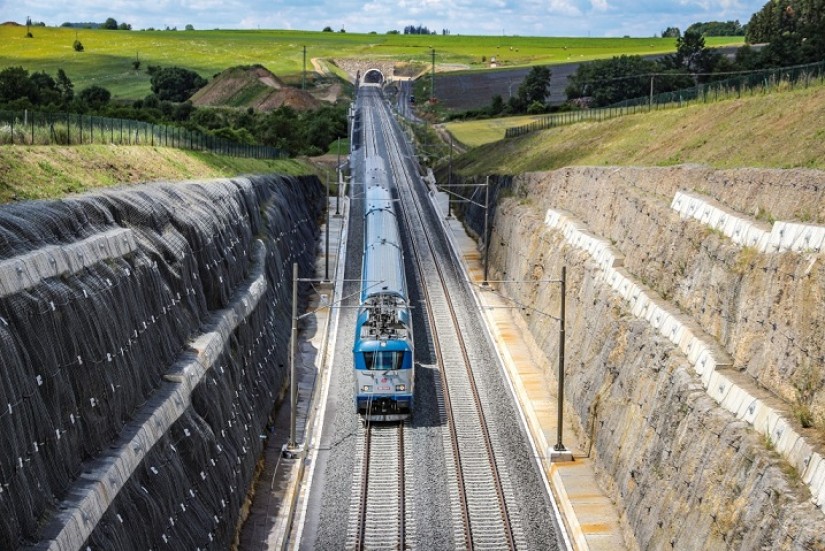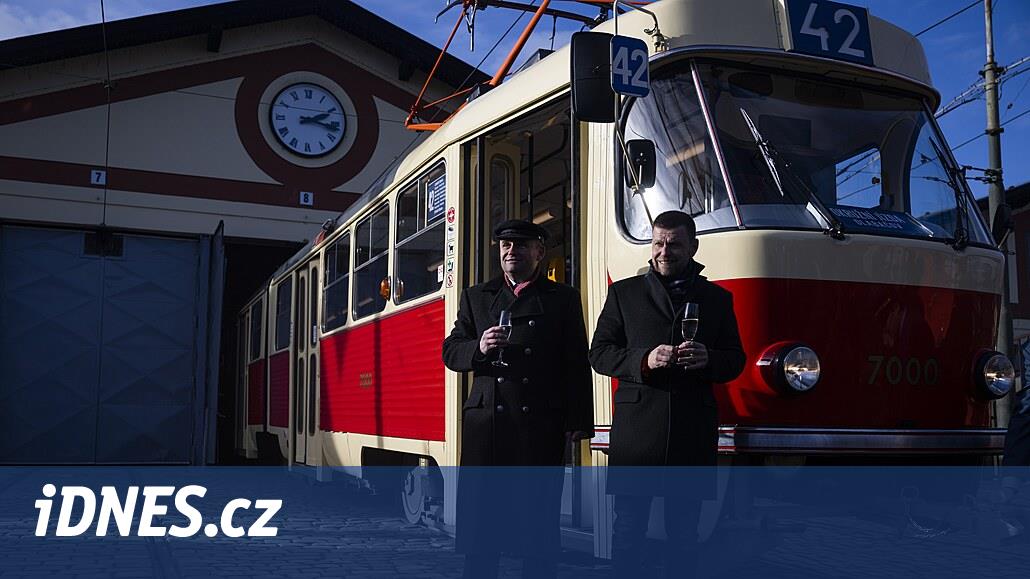From Prague to České Budějovice by train in one hour and forty minutes.
December 10, 2022, lan
10.12. – From Prague to Tábor in 59 minutes and to České Budějovice in 1 hour 40 minutes, express trains will run from the new timetable. In the opposite direction, the journey time will be 2 minutes longer. The journey by train will thus be faster than by car. In addition, people will avoid frequent queues on the I/3 road and the D1 highway and parking problems in the agglomerations where the trains stop.
“On the 4th railway corridor, we offer very fast travel thanks to other completed sections. For all EuroCity and InterCity connections, we have unified the maximum speed at 160 km/h and offers passengers a number of additional services, thanks to which the journey can be used for work or leisure,” said Jiří Ješeta, a member of the board of directors and the name for passenger transport, and listed some of the services: “The trains have a bistro car, WiFi internet connection or sockets for recharging travel electronics.”
The Ex 7 South Express line will be one of the fastest in the Czech Republic and will compete with traffic on roads that are prone to frequent queues in this direction. The traveling (average) speed of trains reaches 98 km/h and between Prague and Tábor it even exceeds 100 km/h. The inhabitants of Tábor and its surroundings will thus get a new fast and convenient train connection for regular daily commuting to work or schools in Prague.
From Sunday, it will be possible to travel between Prague and Tábor from 149 CZK and between Prague and České Budějovice from 215 CZK (timed tickets). Students pay for the trip Prague – Tábor 74 CZK, Prague – České Budějovice 107 CZK and Tábor – České Budějovice 49 CZK. For regular trips, e.g. to work, you can also use train and network tickets. A monthly ticket in 2nd class for regular trips between Tábor and Prague (99 km) with IN 50 applications costs CZK 2,604. With 21 working days, one trip costs CZK 62. Between Tábor and České Budějovice (65 km), such a ticket will cost 1,778 CZK (42.45 CZK one way). You can also use the offer of train tickets for 10 journeys during the monthly validity of the ticket. Tickets can be purchased at current prices until Saturday midnight.
The fastest connection in railway history
“The train journey between Prague and the South Bohemian metropolis will be approximately 20 minutes shorter than in the ending timetable. Compared to the 1980s, however, the driving time has even been cut in half. Back then, it took about 3 and a half hours to travel from Prague to České Budějovice. The new travel times can be used, for example, for a more comfortable daily commute to work or to school on the route České Budějovice – Tábor – Prague and back,” said Jiří Ješeta.
EC / IC trains will now manage the journey between Prague and České Budějovice in 1 hour 40 minutes. The slightly slower Vltava express trains, which have 7 more stops and also stop in Prague’s Vršovice and Zahradní dům, in Benešov, Olbramovice, Planá nad Lužnicí, Soběslav and Veselí nad Lužnicí, make the journey in 2 hours and 4 minutes. Such a short travel time has so far been reserved only for express trains with a single stop in Tábor.
In the future, travel times between Prague and South Bohemia will be further reduced thanks to the modernization of the remaining sections of the 4th railway corridor, and the travel time will be around 90 minutes.
“In addition, the Southern Express is made up of modern cars with air conditioning, on-board Wi-Fi network, 230 V electrical sockets and USB ports for recharging electronics. Passengers on this line also have at their disposal a bistro, wheelchair-accessible places, places for prams and bicycles or tables on which to place a laptop while working. Thanks to this, a number of work matters can already be handled during the trip or, on the contrary, you can devote yourself to leisure activities, such as watching movies, listening to music or reading books and daily news,” explained Jiří Ješeta about the equipment of the modern sets. EuroCity and InterCity trains can use the current maximum speed of 160 km/h on the 4th corridor, making them one of the fastest trains in the Czech Republic. A number of additional services are also being introduced in the Vltava and Lužnice expressways.
Faster to the entire region
“Travel between Prague and many smaller regional centers in the entire South Bohemian Region or in the Vysočina will also be significantly accelerated. Traveling from Milevsko, Pelhřimov, Třeboň, Jindřichova Hradec, Lipno nad Vltavou, Bechyna or Český Krumlov to Prague will be about 20 to 30 minutes faster,” Jiří Ješeta added. For example, the journey from Milevsk to Prague will take less than 2 hours, just over two hours from Bechyně, Jindřichova Hradec or Třeboň and just over two and a half hours from Český Krumlov.
The connection between the South Bohemian Region and other regions of the Czech Republic is also shortened by tens of minutes. For example, the shortest driving time from České Budějovice to Ústí nad Labem will take less than 3.5 hours, to Olomouc it is close to 4.5 hours and to Ostrava it falls below 5.5 hours.
How it was before
In 1880, the journey between Prague and České Budějovice took about 6.5 hours, and it took up to 11 hours to Linz. After the introduction of expressways, the journey time was reduced considerably. However, the main direction was from Prague to the imperial metropolis of Vienna. In Veselí nad Lužnicí, you had to change to a passenger train.
In 1890, the journey by express train between Prague and České Budějovice took approximately 3.5 hours. The camp could be reached in 2 hours, by passenger train in 3 to 3 and a half hours, and it took about 6 hours to travel to Linz. At that time, however, only five pairs of passenger trains and two pairs of Viennese express trains daily traveled from Prague to the south of Bohemia. The traveling speed at that time was around 50 to 55 km/h, and this average speed lasted practically a hundred years. It’s roughly half the current cruising speed.
During the time of the first Czechoslovak Republic, travel times were slowly shortened and the number of trains increased. Express trains managed the journey between Prague and České Budějovice in 3 to 3 and a quarter hours, but the new state border extended the journey to Linz to approximately 7 to 7.5 hours. In 1932, there were already three direct express trains from Prague to České Budějovice, one of which continued to Linz and took direct trains to Split, Trieste, Milan or Rome. Another two pairs of express trains branched off in Veselí nad Lužnicí to Gmünd and Vienna.
In the 1950s, the travel time between the capital and the South Bohemian metropolis was around 3 hours, but with increasing traffic and the deployment of diesel locomotives in the second half of the last century, travel times increased by approximately 3 and a quarter to 3 and a half hours. The journey to Tábor still took more than 2 hours.
Only after the electrification of the entire line, the abolition of sleepers and the deployment of powerful electric locomotives did the first rapid acceleration occur. At the turn of the 1980s and 1990s, travel times to České Budějovice were reduced to 2.5 to 3 hours and to Tábor to 1.5 to 1.34 hours. After 1989, connections to Linz were also restored, where the journey took approximately 5 to 5.5 hours. Travel speed on the South Bohemian Corridor also jumped significantly for the first time and reached almost 70 km/h.
For the next almost three decades, travel times to the south of Bohemia remained unchanged. Only after the start of the modernization of the track, a few minutes of reserve were added due to slow drives through sections under construction. Travel times between Prague and České Budějovice were thus always between 2.5 and 3 hours. However, connections on this line have increased significantly. At the end of the 1980s, there were only five high-speed trains a day, but in the past three decades, a regular service has gradually been established here, and the high-speed trains have been supplemented by faster express trains, today the comfortable EuroCity / InterCity connections. Between Prague and České Budějovice, there are one or two fast trains every hour from morning to evening. This makes traveling flexible and one can flexibly change their daily schedule here.
Another major reduction in travel times came in 2017 after the completion of part of the fourth corridor. The new express trains started to run about 20 minutes faster than the previous connections, and passengers spent only 2 hours on the journey between Prague and České Budějovice. The cruising speed climbed to approximately 85 km/h. The journey from Prague to Tábor then took approximately one and a quarter hours. The journey from Prague to Linz was even shortened by three quarters of an hour to approximately 4 hours.
With the completion of other components on the railway corridor Prague – České Budějovice approximately 23 from timetable 2 approximately 23 to a further twenty-minute reduction in travel times and a significant increase in travel speed, which will reach almost 100 km/h for the first time on this route.
(hind)
Photo: ČD



